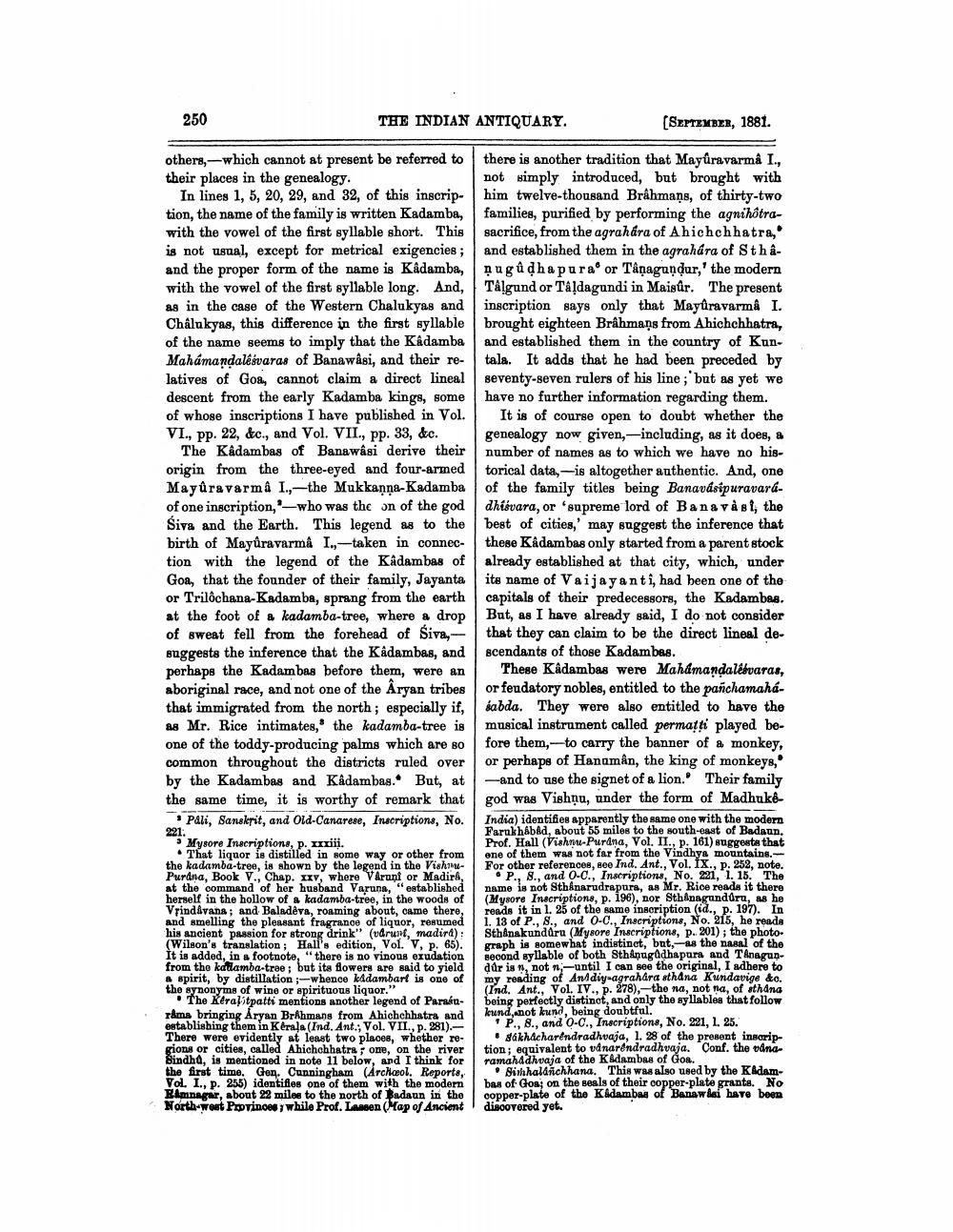________________
250
THE INDIAN ANTIQUARY.
(SEPTEMBER, 1881.
H
others, which cannot at present be referred to their places in the genealogy.
In lines 1, 5, 20, 29, and 32, of this inscription, the name of the family is written Kadamba, with the vowel of the first syllable short. This is not usual, except for metrical exigencies; and the proper form of the name is Kadamba, with the vowel of the first syllable long. And, as in the case of the Western Chalukyas and Chalukyas, this difference in the first syllable of the name seems to imply that the Kadamba Mahamandalesvaras of Banawasi, and their relatives of Goa, cannot claim a direct lineal descent from the early Kadamba kings, some of whose inscriptions I have published in Vol. VI., pp. 22, &c., and Vol. VII., pp. 33, &c.
The Kadambas of Banawasi derive their origin from the three-eyed and four-armed Mayura varma I., -the Mukkaņņa-Kadamba of one inscription, who was the on of the god Śiva and the Earth. This legend as to the birth of Mayůravarma I., -taken in connection with the legend of the Kadambas of Goa, that the founder of their family, Jayanta or Trilôchana-Kadamba, sprang from the earth at the foot of a kadamba-tree, where a drop of sweat fell from the forehead of Siva, suggests the inference that the Kadambas, and perhaps the Kadambas before them, were an aboriginal race, and not one of the Aryan tribes that immigrated from the north; especially if, as Mr. Rice intimates, the kadamba-tree is one of the toddy-producing palms which are so common throughout the districts ruled over by the Kadambas and Kadambas. But, at the same time, it is worthy of remark that
Pali, Sanskrit, and Old-Canarese, Inscriptions, No. 221.
Mysore Inscriptions, p. xxxii. . That liquor is distilled in some way or other from the kadamba-tree, is shown by the legend in the VishPurdna, Book V., Chap. IIV, where Varunf or Madirl, at the command of her husband Varuna, "established herself in the hollow of a kadamba-tree, in the woods of Vrindavana; and Baladeva, roaming about, came there, and smelling the pleasant fragrance of liquor, resumed his ancient passion for strong drink" (udrunt, madird): (Wilson's translation ; Hall's edition, Vol. V, p. 65). It is added, in a footnote, "there is no vinous exudation from the katlamba-tree; but ita flowers are said to yield A spirit, by distillation --whence kadambart is one of the synonyms of wine or spirituous liquor."
• The Kéralitpatti mentions another legend of ParakurAma bringing Aryan BrAhmans from Ahichchhatra and establishing them in Kerala (Ind. Ant.; Vol. VII., p. 281).There were evidently at least two places, whether regions or cities, called Ahichchhatra, one, on the river Sindhd, is mentioned in note 11 below, and I think for the first time. Gen. Cunningham (Archeol. Reports, Vol. I., P. 255) identifies one of them with the modern Elmnagar, about 22 miles to the north of Badaun in the North-West Provinces while Prof. Lassen (Map of Ancient
there is another tradition that Mayûravarma I., not simply introduced, but brought with him twelve-thousand Brahmaņs, of thirty-two families, purified by performing the agnihotrasacrifice, from the agrahára of Ahichchhatra, and established them in the agrahára of Sthanugudhapura or Tanagundur,' the modern Talgund or Tå?dagundi in Maisûr. The present inscription says only that Mayûravarma I. brought eighteen Brâhmans from Ahichchhatra, and established them in the country of Kuntala. It adds that he had been preceded by seventy-seven rulers of his line;' but as yet we have no further information regarding them.
It is of course open to doubt whether the genealogy now given,-including, as it does, a number of names as to which we have no historical data,- is altogether authentic. And, one of the family titles being Banavasipuravaradhisvara, or "supreme lord of Bana và st, the best of cities,' may suggest the inference that these Kadambas only started from a parent stock already established at that city, which, under its name of Vaijayanti, had been one of the capitals of their predecessors, the Kadambas. But, as I have already said, I do not consider that they can claim to be the direct lineal descendants of those Kadambas.
These Kadambas were Mahamandalesvaras, or feudatory nobles, entitled to the pañchamahasabda. They were also entitled to have the musical instrument called permatt played before them,--to carry the banner of a monkey, or perhaps of Hanamán, the king of monkeys, --and to use the signet of a lion. Their family god was Vishņu, under the form of Madhuke India) identifies apparently the same one with the modern Farukhabad, about 55 miles to the south-east of Badaun. Prof. Hall (Vishme.Purana, Vol. II., p. 161) suggeste that one of them was not far from the Vindhya mountains.For other references, see Ind. Ant., Vol. IX., p. 252, note.
• P., 8., and 0-C., Inscriptions, No. 221, 1. 15. The name is not Sthenarudrapura, as Mr. Rice reads it there (Mysore Inscriptions, p. 196), nor Sth Apagundoru, as he reads it in 1.25 of the same inscription (id., p. 197). In 1. 13 of P., S., and 0-C., Inscriptions, No. 215, he reada Sthånakunduru (Mysore Inscriptions, p. 201); the photograph is somewhat indistinct, but, as the nasal of the Beoond syllable of both Sth&nugadhapura and T Anagundur is, not until I can see the original, I adhere to my reading of Andiy-agrahara sthana Kundavide &o. (Ind. Ant., Vol. IV., p. 278), the na, not na, of sthana being perfectly distinct, and only the syllables that follow kund, not kund, being doubtful.
P., 8., and o-c., Inscriptions, No. 221, 1. 25.
sakhacharendradhvaja, 1. 28 of the present inscription; equivalent to vånarendradhvaja. Conf. the vinaramahdahvaja of the Kadambas of Goa.
Sinhalánchhana. This was also used by the Kadambas of Goa; on the seals of their copper-plate grante. No copper-plate of the Kidambas of Banawe have been discovered yet.




